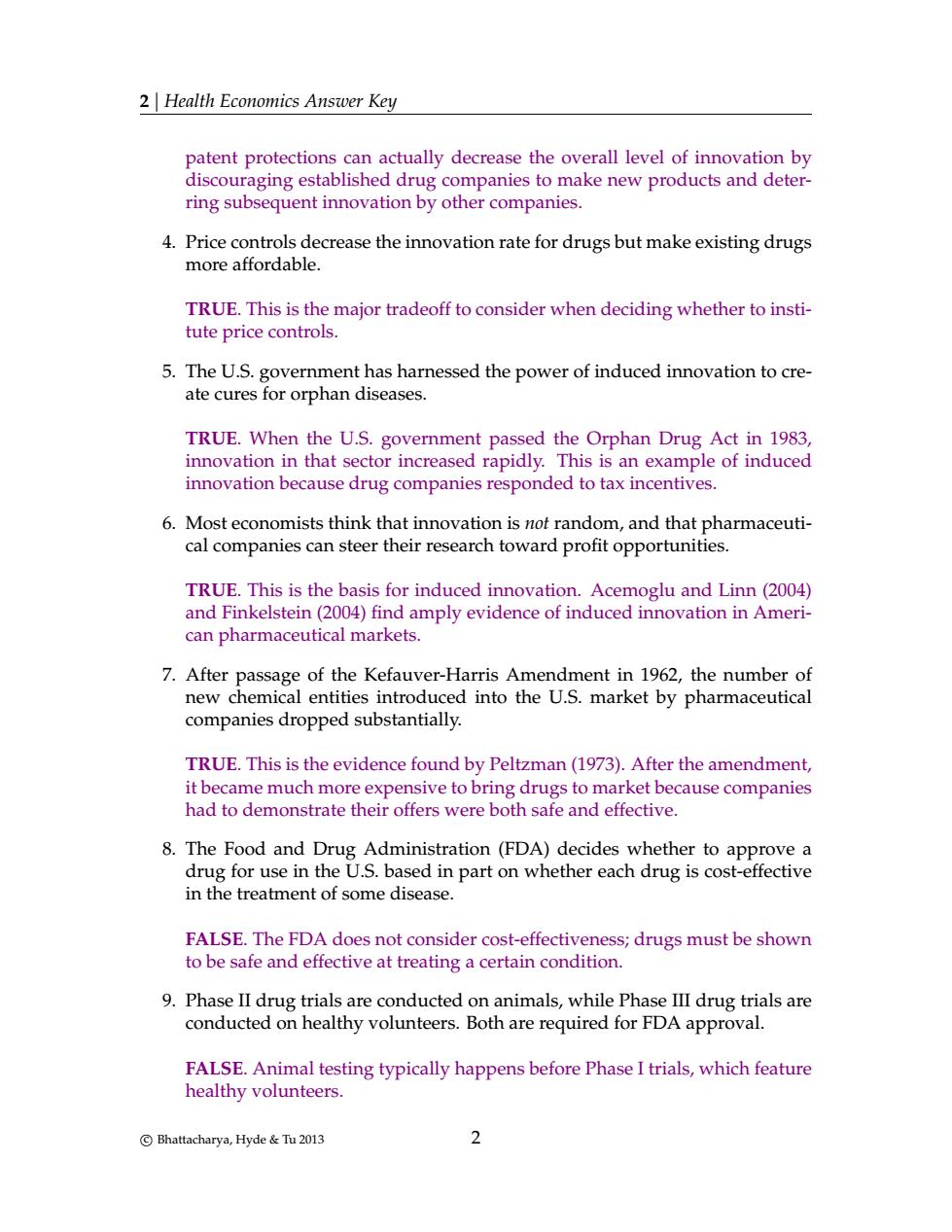正在加载图片...

2 Health Economics Answer Key patent protections can actually decrease the overall level of innovation by discouraging established drug companies to make new products and deter- ring subsequent innovation by other companies. 4.Price controls decrease the innovation rate for drugs but make existing drugs more affordable. TRUE.This is the major tradeoff to consider when deciding whether to insti- tute price controls 5.The U.S.govern ment has harnessed the power of induced innovation to cre. ate cures for orphan diseases. TRUE.When the U.S.government passed the Orphan Drug Act in 1983 innovation in that sector increased rapidly.This is an example of induced innovation because drug companies responded to tax incentives. 6.Most economists think that innovation is not random,and that pharmaceuti- cal companies can steer their research toward profit opportunities. TRUE.This is the basis for induced in vation.Acemoglu and Linn(2004) and Finkelstein(2004)finc of induced innovation in Ameri can pharmaceutical markets amply evider After passage e of the Kefauv er-Ha m is Am endn nent in 1962.the e number new chem l entit intro ed into the U.S. market by pharmaceutical companies dropped substantially TRUE.This is the evidence found by Peltzman(1973).After the amendment, it became much more expensive to bring drugs to market because companies had to demonstrate their offers were both safe and effective. 8.The Food and Drug Administration (FDA)decides whether to approve a drug for use in the U.S.based in part on whether each drug is cost-effective in the treatment of some disease. FALSE.The FDA does not consider cost-effectiveness;drugs must be shown to be safe and effective at treating a certain condition. 9.Phase II drug trials are conducted on animals,while Phase IlI drug trials are conducted on healthy volunteers.Both are required for FDA approval. FALSE.Animal testing typically happens before Phase I trials,which feature healthy volunteers. Bhattacharya,Hyde Tu 2013 2 2 | Health Economics Answer Key patent protections can actually decrease the overall level of innovation by discouraging established drug companies to make new products and deterring subsequent innovation by other companies. 4. Price controls decrease the innovation rate for drugs but make existing drugs more affordable. TRUE. This is the major tradeoff to consider when deciding whether to institute price controls. 5. The U.S. government has harnessed the power of induced innovation to create cures for orphan diseases. TRUE. When the U.S. government passed the Orphan Drug Act in 1983, innovation in that sector increased rapidly. This is an example of induced innovation because drug companies responded to tax incentives. 6. Most economists think that innovation is not random, and that pharmaceutical companies can steer their research toward profit opportunities. TRUE. This is the basis for induced innovation. Acemoglu and Linn (2004) and Finkelstein (2004) find amply evidence of induced innovation in American pharmaceutical markets. 7. After passage of the Kefauver-Harris Amendment in 1962, the number of new chemical entities introduced into the U.S. market by pharmaceutical companies dropped substantially. TRUE. This is the evidence found by Peltzman (1973). After the amendment, it became much more expensive to bring drugs to market because companies had to demonstrate their offers were both safe and effective. 8. The Food and Drug Administration (FDA) decides whether to approve a drug for use in the U.S. based in part on whether each drug is cost-effective in the treatment of some disease. FALSE. The FDA does not consider cost-effectiveness; drugs must be shown to be safe and effective at treating a certain condition. 9. Phase II drug trials are conducted on animals, while Phase III drug trials are conducted on healthy volunteers. Both are required for FDA approval. FALSE. Animal testing typically happens before Phase I trials, which feature healthy volunteers. c Bhattacharya, Hyde & Tu 2013 2